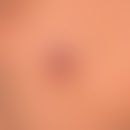Synonym(s)
DefinitionThis section has been translated automatically.
Rare, severe, generalized variant of lichen myxoedematosus with characteristic skin-colored, lichenoid papules, extensive thickening and hardening of the skin with storage of mucins and massively increased fibrosis of the dermis. Frequent (>90%) monoclonal paraproteinemia (MGUS), mostly of the IgG1-Lambda type, less frequently of the IgG-Kappa type (see also mucinoses). IgG1-Lambda is a 7S, papain-sensitive globulin (size approx. 100 kDa), which is strongly basic due to its high lysine content.
You might also be interested in
EtiopathogenesisThis section has been translated automatically.
Unknown.
Pathogenetically, it seems largely certain today that fibroblasts are responsible for the production and accumulation of proteoglycans. The fibroblasts are stimulated by a serum factor that is independent of the paraprotein.
Paraproteinemia: The role of paraproteinemia in the pathogenesis of the disease is unclear. Stimulation of the fibroblasts also occurs after elimination of the paraproteinemia. The paraprotein level does not correlate with the severity of the disease!
Renal insufficiency: In this context, observations of scleromyxoedema-like skin changes in patients with renal insufficiency are noteworthy (Neudecker BA et al. 2005). The relationship to nephrogenic systemic fibrosis is obvious.
Viral infections: The frequent occurrence of the disease in HIV and hepatitis C infections is noteworthy (Rongioletti F et al. 1998; Chen KY et al. 2019). A Chinese working group drew attention to the association of scleromyxedema with chronic hepatitis (Chen KY et al. 2019). In a larger group of patients with lichen myxoedematosus (n=28), hepatitis (hepatitis C> hepatitis B > hepatitis C/B) was diagnosed in 50% of cases. The prevalence of hepatitis C in this clientele was 6.5 times higher than in the general population (28.6 % compared to 4.4 %); the prevalence of hepatitis B, on the other hand, was identical (17.9 % compared to 17.3 %). Polyclonal gammopathy was found in 28.6 % of patients and monoclonal gammopathy in 7.1 %. The extent of clonality did not correlate with the severity of the disease. A significant correlation with monoclonal gammopathy was also not found in this clientele (Chen KY et al. 2019).
ManifestationThis section has been translated automatically.
No gender relation, first manifestation 40th-60th LJ
LocalizationThis section has been translated automatically.
Face, typically infestation of the glabella, neck, arms, hands, trunk of the body
ClinicThis section has been translated automatically.
Scleroderma-like picture: Diffusely thickened facial skin with mimic rigidity, thickened skin of the distal extremities.
Thickened, doughy, hyperpigmented, "too wide" skin that can be lifted off in large bulging folds (see figure).
Multiple, dense, firm, pinhead-sized, often itchy, lichenoid papules arranged in the skin lines, especially on the forehead (glabella), lateral facial region, retroauricularly and on the neck. Symmetrical infestation of the extremities, back and abdomen is less common. The palms of the hands can also be characterized by "scleroderma-like" waxy induration.
Internal organs: sclerosis of renal and coronary arteries with corresponding symptoms, cerebral symptoms, lung involvement (pulmonary fibrosis after years of progression); arthritis, peripheral polyneuropathies, esophageal motility disorders.
Complication: Dermato-neuro syndrome as a rare, acute neurologically accentuated symptomatology with fever, flu-like symptoms, epileptic seizures, confusion with hallucinations and possible fatal consequences.
LaboratoryThis section has been translated automatically.
Monoclonal gammopathy is found in > 90% of patients: IgG-lambda type, rarely IgG-kappa, IgA or IgM paraproteins; also evidence of reactive plasmocytosis (about 10% plasma cells in bone marrow).
HistologyThis section has been translated automatically.
Massive deposits of mucoid substances in the dermis. Cell-rich fibrosis with fibroblast proliferation, degenerated connective tissue fibers, swollen collagen fibers and vessel walls.
In rare cases, (benign) syringomatous hyperplasia may occur, which requires differential diagnosis with malignant sweat gland tumors (Bertlich I et al. 2024).
Differential diagnosisThis section has been translated automatically.
Scleroderma, systemic: Skin sclerosis, usually onset with involvement of upper extremities(acrosclerosis), Raynaud's symptoms, possibly dome necrosis, characteristic facial symptoms, occurrence of ANA and highly specific ENA, characteristic organ involvement.
Scleroderma, disseminated circumskripte: Mostly painless, chronic stationary, localized to trunk and extremities, extensive, white, red, or brown indurations. No papulosis. No organ involvement. Histology is demarcatingly demonstrative. Usually no serologic autoimmune phenomena.
Fibrosis, nephrogenic systemic (rare): Plaque-like and/or diffuse, board-hard (woody) thickening and induration of the skin, subcutis, and underlying musculature with brownish, yellowish discoloration. No papulosis. Onset of skin lesions on extremities, then spread to trunk. Face usually left out. Burning pain, itching. Patients are severely ill!
Scleroedema adultorum: Principle: "athlete's back"! Massive back and neck contour (bull neck) with firm consistency, either not noticed at all by the pat. or rather accidental. No papulosis. No discoloration of the skin. Diabetes and obesity.
Fasciitis, eosinophilic: V.a. on forearms; rarely on trunk and face. Doughy, painful, red swelling with subsequent dermal induration of skin and subcutaneous fat. This causes pseudo cheek skin phenomenon. Frequent development of joint contractures and carpal tunnel syndrome. Occasional accompanying arthralgias, myositis, paresthesias of the fingers. No involvement of internal organs, no Raynaud's phenomenon. Blood eosinophilia, CRP elevation, and hypergammaglobulinemia.
Myxedema, pretibial: Pretibial, coarse, difficult to depress induration; peau d'orange, hypertrichosis, always hyperthyroidism.
Mucinoses of other genesis (see mucinosis(s) below).
TherapyThis section has been translated automatically.
No causal therapy known. Therapy of the skin lesions was successful in individual cases with the following therapy modalities:
- In purely cutaneous, limited infestation pattern:
- Retinoids: Isotretinoin (e.g. Isotretinoin-ratiopharm; Aknenormin) initially 0.5 mg/kg bw/day, maintenance therapy according to clinic.
- Irradiation: Alternatively initiation of PUVA therapy or RePUVA therapy.
- In case of extensive systemic involvement pattern u./o. evidence of gammopathy u./o. systemic involvement:
- IVIG. In the meantime, most patients worldwide have been treated with IVIG with remarkably good results (2 times complete healing), especially in the Anglo-American region. The dosages were in the high therapy range (2 g/kg bw! distributed over several days); therapy intervals of 4 weeks. Therapy duration 6 months up to 3 years (Haber R et al. (2020)
.Note! Probably the most promising therapy principle (optimal dosages still unclear) with unfortunately very high therapy costs!
- Glucocorticoids in combination with cytostatics: prednisone (e.g. Decortin) 80-100 mg/day combined with cyclophosphamide (e.g. Endoxan) 150-200 mg/day p.o., gradual dose reduction. Aim for maintenance therapy around 50 mg/day. Alternative shock therapy: prednisone 500-1000 mg i.v. every 2-4 weeks, then extend intervals. Alternative: combination with dexamethasone 40 mg p.o. for 4 days every 4 weeks.
- Alternative: Plasmapheresis in combination with immunosuppressants such as cyclophosphamide: This is a therapeutic principle for which good long-term success has been described. Early initiation of therapy improves success.
- Alternative: Melphalan (Alkeran): Relatively good response with relatively high rate of side effects. Maintenance therapy at 1-10 mg/day p.o.
- Alternative: IVIG+Thalidomide. In individual cases, successful monotherapeutic, or with IVIG-combined, use of thalidomide 100 mg/day p.o. has been described (Haber R et al. 2020) . Monotherapy for 2 years, improvement is expected after about 6 months.
- Alternative: photopheresis, extracorporeal: trial with extracorporeal photopheresis has been described with success in individual cases of therapy resistance.
- Radiotherapy with fast electrons (for cutaneous foci, dose: 7 MeV electrons, several sessions up to a GD of 16-28.5 Gy).
- Alternative: chloroquine/ hydroxychloroquine (Resochin, Quensyl): Successful in casuistry for a short time, especially in joint immobility d. extremities. Initially 600 mg/day p.o. for 10 days, then 400 mg/day p.o. for 4 weeks; subsequently 200 mg/day p.o. Success of therapy can be assessed after 6 months at the earliest.
- Alternative: stem cell therapy; this is now used as a therapeutic agent for many diseases. Stem cells can be classified on the basis of their origin and their ability to differentiate. In the skin, they are found in the interfollicular epidermis, hair follicle, dermis, and adipose tissue, where they contribute to the maintenance of normal skin homeostasis and to repair and regeneration in response to injury (Haber R et al. 2020; Khandpur S et al. 2021).
- IVIG. In the meantime, most patients worldwide have been treated with IVIG with remarkably good results (2 times complete healing), especially in the Anglo-American region. The dosages were in the high therapy range (2 g/kg bw! distributed over several days); therapy intervals of 4 weeks. Therapy duration 6 months up to 3 years (Haber R et al. (2020)
Progression/forecastThis section has been translated automatically.
Case report(s)This section has been translated automatically.
- The 55-year-old patient first noticed diffuse swelling and a feeling of tension in the face and on the extensor sides of the upper extremities about 10 years ago. Over the years, there had been a gradual hardening of the entire skin with movement restrictions, initially in the hands and later progressively in the elbows and shoulder joints. The diagnosis of scleromyxedema was made in 2003.
- The following therapies were used in the order listed: hydroxychloroquine for 1.5 years (dosage: initially 400 mg/day for 4-8 weeks, then 200 mg/day). No palpable effect. Isotretinoin 8 months (dosage: 20 mg/day). Discontinuation due to progression. Intermittent UVA-1 cold light therapy (see phototherapy below) (dosage: 2520 J/cm2). Therapy success was noticeable but not satisfactory.
- Findings: In the clearly obese patient a continuous diffuse, coarse (almost woody) hardening of the homogeneously brownish tinged integument was detectable, which could only be dented by firm permanent pressure. There were flexion contractures of several joint systems (hands, shoulders). Dense, firm, shiny, skin-colored papules and plaques were demonstrable retroauricularly and in the frontal area. Marked microstomia (scleroderma-like facial aspect).
- Laboratory: monoclonal gammopathy type-IgG lambda. Mild lymphocytosis, ESR 35/70; CRP markedly elevated.
- Therapy: 4-week repetitive IVIG (1 g/kg bw distributed over 3 days); duration of therapy: 2 years (possibly longer).
- Results: Significant decrease in skin induration, which was detectable both subjectively and objectively (20 MHz sonography and histology).
LiteratureThis section has been translated automatically.
- Berkson M et al. (1991) Extracorporeal photochemotherapy: a potentially useful treatment for scleromyxedema. J Am Acad Dermatol 25: 724
- Bertlich I et al. (2024) Unusual variant of scleromyxedema presenting with severe systemic involvement and atypical adnexal proliferations - A histological pitfall with the risk of unnecessary surgeries. J Dtsch Dermatol Ges 22: 434-437.
- Charles S et al. (2014) Dermato-neuro syndrome during scleromyxedema: efficacy of plasmapheresis and intravenous immunoglobulin. Ann Dermatol Venereol 141:523-527
- Dubreuilh W (1908) Fibromes miliares folliculaires: Sclérodermie consécutive. Arch Derm Syph 91: 569-572
- Durani BK (2001) Extracorporeal photophoresis - therapeutic option for scleromyxedema. Dermatologist 52: 938-941
- Gerstner S et al. (2014) Differential diagnosis of angioedema. Acute edematous scleromyxedema]. Dermatologist 65:454-457
- Gottron HA (1954) Scleromyxedema (A peculiar manifestation of myxothesauroderma). Arch Derm Syph 199: 71-91
- Haber R et al (2020) Scleromyxedema treatment: a systematic review and update. Int J Dermatol 59:1191-1201.
- Khandpur S et al (2021) Stem cell therapy in dermatology. Indian J Dermatol Venereol Leprol 87:753-767.
- Kövary PM et al (1980) Arndt-Gottron scleromyxedema - a paraproteinemic dermatosis. Act Dermatol 6: 155-163
- Neudecker BA et al. (2005) Scleromyxedema-like lesions of patients in renal failure contain hyaluronan: a possible pathophysiological mechanism. J Cutan Pathol 32:612-615.
- Rongioletti F et al. (1998) Cutaneous mucinoses and HIV infection. Br J Dermatol 139:1077-1080.
- Sansbury JC et al. (2004) Treatment of recalcitrant scleromyxedema with thalidomide in 3 patients. J Am Acad Dermatol 51: 126-131
- Topf S et al. (2007) Significant improvement of Arndt-Gottron scleromyxedema with high-dose intravenous immunoglobulins. Dermatologist 58: 525-528
- Wetter DA et al. (2005) Effectiveness of intravenous immunoglobulin therapy for skin disease other than toxic epidermal necrolysis: a retrospective review of Mayo Clinic experience. Mayo Clin Proc 80: 41-47
Incoming links (14)
Arndt-gottron syndrome; Cutaneous focal mucinosis ; Cutaneous mucinosis of infancy; Histiocytosis, hereditary, progressive, mucinous; Ivig; Lichen myxoedematosus discrete type ; Lichen myxoedematosus generalized; Multiple cutaneous focal mucinosis ; Myxoedema tuberosum; Nephrogenic systemic fibrosis; ... Show allOutgoing links (24)
Acrosclerosis; Arndt georg; Circumscribed scleroderma; Cytostatics (overview); Dexamethasone; Fasciitis eosinophil; Gottron, henry a.; Hydroxychloroquine; Isotretinoin; Lichen myxoedematosus discrete type ; ... Show allDisclaimer
Please ask your physician for a reliable diagnosis. This website is only meant as a reference.





















